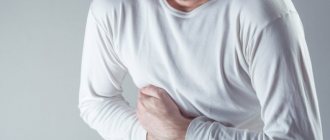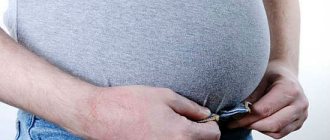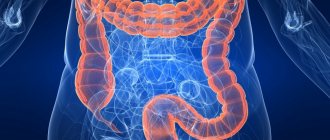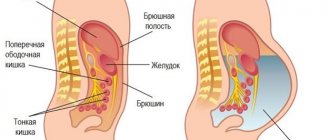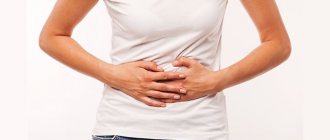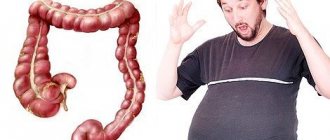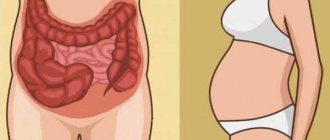Symptoms of gas accumulation in the intestines
Flatulence or excessive gas formation is a very common syndrome indicating problems in the functioning of the digestive system.
In a healthy intestine, there are 200-400 ml of gases (a mixture of O2, CO2, N2, H2S), they are evenly distributed in the contents of the digestive tract. They enter the gastrointestinal tract during eating and drinking; a small amount is formed in the stomach, as well as as a result of fermentation in the colon.
The physiological amount of gases does not bring discomfort or unpleasant sensations to a person. If it is increased or its evacuation is impaired, painful and unpleasant sensations develop.
Let's list the symptoms that patients know firsthand when they suffer from gas in the stomach and intestines during the day or in the morning:
- Belching of air or rotten things.
- Feeling of bloating, fullness, pressure in the epigastrium after eating.
- Hiccups.
- The pain along the intestines is cramping in nature; patients often characterize it as follows: “cuts like a knife,” “stomach grabs.” Such pain manifests itself in attacks, but can be permanent and decrease somewhat after the passage of gas. And as new portions accumulate, they intensify. Also, pain due to flatulence becomes less intense or goes away after defecation.
- Rumbling, feeling of transfusion in the stomach.
- Stool disorder, it becomes unstable. Constipation and diarrhea may alternate.
- An increase in the volume of the abdomen - bloating.
- Palpitations, feeling of lack of air, cardiac pain. “Pseudosymptoms” of cardiac pathology develop due to the fact that most of it can accumulate under the diaphragm, in the area of the splenic flexure; irritation of the nerves approaching the mediastinal organs can give such symptoms.
- Astheno-neurotic manifestations: excessive irritability, depression, mood swings, sleep disturbances may also accompany this condition.
- Loss of body weight.
- Excessive passage of gases, unpleasant odor during passage.
Normally, the evacuation of gases (from 200 ml to 1.8 l) occurs through the anus; on average, a person can make from 5 to 13 passages per day per day, most of which is absorbed into the blood.
With flatulence, gas separation is accompanied by an unpleasant odor and noise, which brings both physiological and psychological discomfort. The patient begins to feel embarrassed about such manifestations of his body and to restrain natural discharge. Because of this, the clinic is only progressing: spastic and bursting pains are intensifying.
Symptoms and causes of flatulence in infants and young children
The No. 1 reason for sleepless nights for mother and baby is increased gas formation in small tummies, and intestinal colic that appears against this background in children.
The digestive tract of a newborn is immature; from the moment of birth to 3-4 months, its further development, the formation of microflora, and the formation of work and functioning occur. It is the immaturity of the gastrointestinal tract that explains these problems in children.
Another common cause may be swallowing air during feeding if:
- baby cries while feeding
- does not grasp the breast correctly (takes only the nipple into the mouth, not the areola)
- air gets into the nipple when feeding, or it is not selected correctly
If the child is breastfed, and the mother “sins” by eating food that promotes gas formation, then bloating and colic can become a faithful companion to sleepless nights in such a family.
Lactose intolerance, poor-quality formula, excessive consumption of fast carbohydrates (sweets, flour), enzymatic deficiency, helminthic infestations, microflora disturbances are all possible reasons for the development of this symptom in children.
You can suspect this condition if the baby:
- hysterically, crying a lot, screaming
- when crying, pulls legs towards stomach
- Screaming attacks begin unexpectedly and also disappear unexpectedly
- When the baby stands upright, air escapes in the form of belching
- frequent regurgitation occurs
- The child's anxiety attacks are observed a short time after eating, often at night.
To avoid colic and bloating in infants, it is recommended to carry the baby in a column for 5-20 minutes after feeding and wait for him to burp air, monitor your diet when breastfeeding, and give the baby only a high-quality adapted formula.
In older children, you should carefully monitor their diet, prevent helminthic infestations, and instill in children a regular diet.
Children 2-3 years of age and older with a labile nervous system, hyperactive, and excitable are more susceptible to this disease. The whole point is that increased nervous impulses are transmitted to the gastrointestinal tract, which is manifested by impaired peristalsis and digestion, and as a result, is accompanied by these symptoms.
It should be understood that increased gas formation in both adults and children is not an independent disease, but only a consequence of one or another pathology, which in most cases is associated with the gastrointestinal tract, but can also be a manifestation of other conditions.
This symptom always has an underlying cause. And the doctor’s task is to install it correctly.
What diseases may the combination of these symptoms indicate?
- The cause of colic in adults can be diseases of the digestive system. Such diseases include ulcers, gastritis, malfunctions of the gallbladder, liver, and pancreas. In this case, digestive disorders occur. Food begins to be poorly digested. It enters the small intestine, causing painful spasms.
- Colic is caused by food intoxication from low-quality or expired food. Toxins accumulate in the body, causing bloating, vomiting and nausea. In this case, treatment must be started urgently, before the toxins have time to be absorbed into the human blood.
- Cramps and flatulence can cause intestinal infections. At the same time, pathogenic microbes enter the body and cause toxins. Intestinal infections include salmonellosis, cholera, and dysentery.
- The disease is caused by nervous diseases. These include stress and nervous tension. In most cases, this manifestation occurs in impressionable people who have a thin physique. Patients also suffer from congenital malposition of the intestines.
- An unpleasant manifestation is caused by infection with helminths. Parasites located in the intestines affect the mucous walls. At the same time, pain occurs in the abdomen and appetite decreases. A person loses weight catastrophically. Flatulence occurs and the person begins to swell.
- Another cause of an unpleasant illness is influenza and ARVI. Viral infections begin to affect the digestive and respiratory systems. Pathogenic microorganisms settle in the lymph nodes of the abdominal cavity. In this case, severe inflammation, colic and spastic pain occur.
- Intestinal colic occurs due to obstruction of stool in the intestines. There is a violation of his motility, the accumulation of feces in the intestines, the occurrence of pain, and stretching of the intestinal loops. The cause may be mechanical barriers in the form of adhesions or tumors. This manifestation is formed due to heavy lifting or intense physical stress on the body.
Causes and treatment of bloating in adults
Patients who suffer from this condition are concerned about the following question: what causes bloating?
There are many reasons for the condition in which, as people say, “swelling”. Here are the main ones:
Swallowing air or aerophagia
Excessive swallowing of air, both during and outside of meals, can occur when:
- hasty absorption of food, slurping, talking and laughing during the meal
- difficulty breathing through the nose
- sore throat with pain when swallowing
- diaphragmatic hernia
- hysteria, psycho-emotional shocks
- excessive salivation and swallowing (smoking, sucking on lollipops)
The main symptom of excessive air intake in this way will be belching, loud and sonorous. It can also bother you outside of meals.
Eating foods that cause bloating, often and in large quantities
Products that pollute the gastrointestinal tract include:
- legumes
- carbonated drinks, including alcoholic drinks
- milk
- baked goods and brown bread
- fresh fruits and vegetables
- mushrooms
- as well as any food to which there is an individual intolerance
When consuming the above products, fermentation processes actively occur inside the digestive tract.
For comparison, you can imagine a bottle of young home-made grape wine with a glove on the neck. What happens to the glove during active fermentation? She's bloated. The intestinal loops are also swollen from excessively produced gases.
Stressful situations
Banal stress can provoke flatulence. The increased release of hormones has a slowing effect on peristalsis, which is why the evacuation of air can slow down and its excess accumulate.
Dysbacteriosis
“Beneficial inhabitants” of the intestines - bifidobacteria and lactobacilli are responsible for order in the gastrointestinal tract and ensure that the “harmful inhabitants” do not actively reproduce. This maintains microflora balance and ensures good digestion.
But as a result of a decrease in the body’s immune forces, long-term use of antibacterial drugs, chronic infections, a shift in the balance occurs: the number of pathogenic microbes can increase sharply, and the number of beneficial ones can decrease.
The result of dysbiosis can be bloating, and not only that. Symptoms include stool disorders, nausea, pain, unpleasant taste in the mouth, and the appearance of pieces of undigested food in the stool.
Lactose intolerance
The enzyme lactase works to break down milk sugar or lactose into smaller subunits - monosaccharides. Only they are able to be absorbed into the blood and go to the needs of the body. Lactose itself is not able to penetrate the intestinal capillaries and the bloodstream.
With a deficiency or complete absence of lactose, milk sugar transits to the lower intestinal sections, where it becomes food for the microorganisms that inhabit them. Colon bacteria eat sugar and trigger active fermentation mechanisms.
Manifestations of this pathology, in addition to flatulence and rumbling in the abdomen, include loose, foamy stools, pain, nausea, and weight loss.
There is a congenital form, which manifests itself from early childhood, and an acquired form, which affects adults after infectious diseases, or with developing age-related enzyme deficiency
Celiac disease
A genetic enzyme defect that causes intolerance to the gluten protein found in cereals.
The clinical picture can be very bright, progressing after eating gluten-containing foods: frequent profuse loose stools, with an admixture of fat and mucus in the stool, sharp pain, rumbling, heaviness.
The disease can occur in a latent form, when excess air accumulation is the only clinical symptom.
Chronic gastrointestinal diseases
The digestive tube cannot function separately from its sections and organs involved in digestion. Problems in the stomach will undoubtedly affect the functioning of the colon.
Chronic pathologies - gastritis, enteritis, liver and pancreatic lesions, intestinal colitis, infectious processes disrupt both motor and enzymatic activity, accompanied by excessive gas production and impaired gas removal.
IBS
The variant of irritable bowel syndrome with flatulence is one of several in the classification of this exclusion diagnosis. This disease is so named because it can be diagnosed only after a thorough examination and the absence of convincing evidence for organic disorders in the digestive system.
Stressful situations, poor diet, endocrine disorders, and physical inactivity can provoke the development of IBS.
Under the influence of provoking factors, an imbalance in the activity of the vegetative system, an imbalance of hormones produced by the digestive system is disrupted, and the processes of absorption and evacuation of the contents of the gastrointestinal tract are disrupted.
The clinical picture is dominated by bloating, pain, bowel dysfunction, neurosis-like manifestations (headache, feeling of lack of air, mood lability, irritability)
In case of IBS, pathological changes in laboratory tests, as well as signs of organic pathology, are not detected during instrumental examination.
Tumors
Formations of the gastrointestinal tract and nearby organs can mechanically prevent the passage of food gruel and gases. Impaired evacuation leads to symptoms and pain.
Differences between intestinal colic and other similar conditions
- Intestinal colic is accompanied by severe abdominal pain that occurs due to problems with the gastrointestinal tract.
- Intestinal colic with bloating indicates the formation of flatulence.
- Spasms, colic, and a feeling of nausea may indicate food intoxication.
- Intestinal colic and bitterness in the mouth indicate liver failure.
- Acute pain on the right side, colic in the abdominal area may indicate an acute form of appendicitis.
If symptoms occur accompanied by colic in the stomach, you must contact a specialist to determine the cause. After diagnosis, appropriate treatment must be prescribed.
How to cure bloating and intestinal pain
The treatment tactics for this symptom will depend on many factors that the doctor pays attention to:
- patient age
- cause of clinical symptoms
- its duration
If pain and bloating appeared recently and bothered you for a short time, decreased or completely disappeared after the passage of gas and bowel movements, the patient can associate them with errors in nutrition - there is no good reason for concern.
The situation is completely different with regularly recurring, long-term disturbing symptoms.
What is bloating
Bloating is characterized by the accumulation of gases in the intestines due to disruption of the digestive process.
The reasons for this can be very different. This pathology can manifest itself visually. It provokes an enlargement of the abdomen and an unpleasant feeling of fullness from the inside. Such symptoms cause severe discomfort and bring a lot of trouble, disrupting the quality of life. Bloating can periodically occur in healthy people, but more often this symptom indicates the development of certain pathologies.
Constant bloating - what to do
A thorough examination and identification of the cause is 99% of successful treatment of this pathology. You should definitely undergo all procedures and studies recommended by your doctor. The minimum list of studies is as follows:
- general clinical tests of blood, urine, BAC (determination of total protein and its component fractions, bilirubin, ASAT, ALAT, glucose, electrolytes, cholesterol, urea and creatinine)
- scatological analysis, microbiological analysis of feces with a study of the thoroughness of fiber digestion, study of the presence or absence of protozoa and parasites
- examination of stool for dysbacteriosis
- FEGDS
- Ultrasound of the abdominal organs
- intestinal colonoscopy, if necessary with mucosal biopsy
- sigmoidoscopy
- study of motor activity of the gastrointestinal tract: electrogastroenterography, manometry
The range of research is quite wide. And this is understandable: it is important not to suppress the symptom with a pill, but to identify its original source. Sometimes this is not easy to do, so you have to resort to instrumental and laboratory “assistants” in diagnosis.
When all the research has been carried out, the “root of evil” has been identified - the reasons for the unpleasant clinic, and treatment begins.
Pain during flatulence localization
With the appearance of pain in the abdominal area, the human body gives a signal that there has been a malfunction in the functioning of the internal organs. The abdominal cavity contains many important organs: the stomach, liver, spleen, intestines, prostate gland (in men) and ovaries (in women). And depending on where the pain is localized, you can determine which organ the problem is with. But only a specialist can do this.
Next we will talk about different places of localization of pain during flatulence.
On the left side
The appearance of a sharp pain in the left side may be a consequence of simple excess gas formation (flatulence), because its main symptoms are bloating, pain and pain in the abdomen.
But pain in the left side can also be a symptom of various diseases, often very serious. And even mild pain, if you do not consult a doctor in a timely manner, can lead to disastrous consequences. Aching pain indicates inflammatory processes. If the pain is nagging, then this indicates that purulent foci have appeared, and if it is stabbing, it indicates organ damage.
Very often, bloating, accompanied by pain, is observed in people with:
- Gastritis, gastric and duodenal ulcers. But along with this, there are other symptoms - nausea, heartburn, feeling of heaviness, belching with a bad smell, weight loss.
- Pathologies of the spleen. Since this organ, which takes part in blood formation, is located very close to the skin, it is susceptible to injury.
- Diseases of the lungs and heart muscle.
Lower belly
Bloating and pain in the lower abdomen are not in every case associated with poisoning, constipation or digestion. The abdominal wall in its normal state is elastic in athletic people and soft in those who do not play sports. During palpation, the doctor feels the internal organs well, and the patient does not experience pain. Only if, for example, the bladder is full at the time of the examination, will the patient feel a little uncomfortable.
The abdomen can become bloated due to swallowing air, eating fatty foods that complicate gastric emptying, and, surprisingly, stress. The bladder and organs of the reproductive system can cause similar symptoms.
Flatulence, accompanied by pain in the lower abdomen, occurs due to:
- Constipation associated with dehydration, lack of fiber in the diet, premenstrual syndrome, pregnancy, painkillers and antacids, sedentary lifestyle and depression.
- Gluten or lactose intolerance, which is caused by the lack of enzymes in the body necessary for the absorption of these substances; This is what causes digestive disorders.
- Parasitic infestation, allergies, hormonal disorders, as well as adhesions that occur after surgical interventions.
- Hyperactivity of the immune system, hypersensitivity of the mucous membranes after a bacterial infection, or excess serotonin in the body.
- Crohn's disease, considered hereditary; it is characterized by a constant inflammatory process, against the background of which the intestinal walls are deformed and the patient suffers from weakness, fever, diarrhea and pain in the lower abdomen.
- Intestinal obstruction, which requires surgical intervention by a doctor. This condition is accompanied by nausea, loss of appetite, bloating, and severe abdominal pain.
But it’s not just problems with the digestive tract that cause pain in the lower abdomen. In some cases, they, along with excess gas formation, may occur in women who have problems with the reproductive system.
These include:
- Ectopic pregnancy with pain starting from the second week of fetal development. And after a tubal abortion, one of the main symptoms, along with pain in the pelvis, which is in the nature of contractions and low blood pressure, is bloating.
- Painful menstruation or premenstrual syndrome, causing flatulence due to hormonal fluctuations.
- Endometriosis, expressed by painful menstruation, as well as discomfort due to sexual intercourse or intestinal fullness.
- An ovarian cyst, due to which there is pain in the lower abdomen, the woman feels nauseous, she suffers from intestinal spasms and bloating, and it hurts during sexual intercourse.
- Inflammatory processes in the pelvic organs also cause pain in the lower abdomen and discharge in the middle of the cycle.
On the right side
Flatulence, combined with pain that occurs in the right side, signals disorders in the gastrointestinal tract. If colic does not last long and then goes away, then no medical intervention is required, but if it does not stop within a few days, then you should immediately consult a specialist.
First of all, this is necessary in order to exclude appendicitis, which is characterized by an acute onset. A person who feels generally well may suffer from severe pain in the abdominal area and even wake up at night from a sudden outbreak of pain. Starting in the epigastric region, the pain is initially vague, and only over time it descends to the right side, clearly localizing there.
Another pathology in which pain is localized in the right side is intestinal obstruction. Its development is based on a delay in the passage of feces or its complete absence. The intestines can be blocked by fecal stones, neoplasms or foreign bodies present in it. Adhesions, spasms of smooth muscle muscles, and volvulus of the intestinal loop also lead to obstruction. An acute pathology can lead to inflammatory processes in the abdominal cavity, blood poisoning and death.
In the rectum
In people suffering from flatulence, excess gases often cannot freely exit the intestines and these people, feeling cramps, bloating and pain in the abdomen, cannot relieve themselves of gases; they have to live with a feeling of constant discomfort.
Gases can accumulate in the rectum and cause pain due to:
- Eating large amounts of foods that cause the formation of gas in excess quantities - beans, peas and others.
- Constipation, which prevents the passage of air from the intestines because there is a lot of feces in the intestines.
- Dysbacteriosis, in which there are much more harmful bacteria in the intestines than beneficial bacteria involved in the breakdown of food.
- Impaired intestinal motility due to stress.
In the groin on the right or left
Both women and men can experience pain in the groin area on the right or left.
If the left lower abdomen hurts during bloating, but there is no clear location of the pain and its boundaries are blurred, then this may indicate that gases have accumulated in the colon.
Pain in the groin area on the right can be caused by appendicitis (provided that over time they only become more intense and the localization is clear), swelling in the main part of the colon, inguinal hernia or ectopic pregnancy.
Treating air in the intestines - what to do
If we do not take into account acute surgical pathology or trauma with penetrating damage to the intestinal wall and the appearance of air in its lumen against this background, gastrointestinal pathologies accompanied by flatulence are treated conservatively.
Treatment tactics depend entirely on the underlying cause. Targeting the underlying disease reduces or completely eliminates pain and bloating.
If these symptoms are signs of dysbiosis, it is necessary to normalize the microflora. For this, prebiotics are used - substances that promote the growth of beneficial microorganisms (pectin, inulin, lactulose) or probiotics - live microorganisms, representatives of normal microflora (bifidumbacterin, bificol, lactobacterin, acylact, linex).
In case of severe enzyme deficiency, it is useful to take drugs that contain pancreatic enzymes: pankeratin, mezim, festal, creon.
If there are prerequisites in the body for increased formation of toxic substances, the doctor will definitely prescribe enterosorbents (smecta, polyphepan, enterosgel). They reduce bloating, normalize the motor function of the gastrointestinal tract, reduce the number of bacterial toxins, allergens, and improve the condition of the immune system as a whole.
In case of IBS, the elimination of psycho-emotional disorders significantly reduces clinical manifestations. The complex of therapeutic measures for this disease, in addition to medications, includes consultation with a psychotherapist, autogenic training, positive self-hypnosis, and relaxation.
To relieve pain in IBS, belastesin, spasmoton, no-spa, and duspatolin can be prescribed.
Treatment, what to do, how to treat pain
There are several techniques that help well with this disease. They must be used for pain in the abdominal area, false vomiting and flatulence. The patient feels better, nausea and active pain go away. You need to consult a surgeon, urologist, gastroenterologist. They will help prescribe the correct treatment.
In what cases do you need specialist help?
1 When signs of dyskinesia occur in children under three years of age.
2 Elderly people.
3 When blood clots are found in feces.
4 In case of vomiting there is an admixture of bile.
5 Attacks of spasms and pain do not go away for a long period of time.
6 When the pain is unbearable, and spasms lead to fainting.
7 The bloating was due to a food allergy.
8 Pregnant and breastfeeding women should definitely rush to see a doctor.
9 For pain and cramping in the abdominal cavity after surgery.
Tablets and medications for bloating, which ones to choose
Antispasmodics:
1 Drotaverine - from a number of myotropes, antispasmodic. Contraindicated in people with sensitivity to some components of the drug.
2 Becarbon - suppresses colic, used for gastritis. Cannot be taken if you have glaucoma.
Injectable:
1 Atropine - available in drops. Helps eliminate colic of smooth muscles of the gastrointestinal tract. It should not be used by anyone who is allergic to this drug.
2 Papaverine - for spasms of the muscular surface of the abdomen. It is prohibited for those with liver failure.
3 Diphenhydramine - to eliminate anaphylactic shock and serum sickness. Contraindications: prostatic hyperplasia.
If during colic there are also signs of intoxication of the body, then an additional course of antibiotics is prescribed:
1 Gentamicin - infectious diseases with catarrhal manifestations. If there are neuritis of the auditory nerves, then the drug is discontinued.
2 Levomycetin - brucellosis, inflammation of the mucous wall of the lungs, dysentery. Cannot be used by people with blood diseases.
And also intestinal disinfectants:
1 Biseptol is a sulfonamide drug. Contraindicated with damage to the tissue surface of the liver.
2 Furozalidone is an antibacterial agent. Lactating and pregnant women are not allowed.
In extremely difficult situations, drugs are prescribed intravenously (glucose), as well as vitamins, water-salt solutions (Ringer's, Sodium Chloride), and blood plasma.
Traditional methods of treatment
You can also help yourself get rid of the disease at home.
1 When there is swelling and increased gas production, pumpkin seeds will help. First you need to grind them. Two teaspoons must be poured into two glasses of boiling water. You can add sugar or honey sweet solution (optional). Should be taken half an hour before meals. The course of treatment is up to a week.
2 Pyzhmovye inflorescences. Pour one and a half dessert spoons of dried flowers into a glass of boiling water. Leave for 30 minutes and strain. Take one third of a glass up to three times a day. Course up to 3 days.
3 The following essence will help with bloating and diarrhea: alder fruits, cinquefoil root, thyme, nettle and dry mint. Mix everything in equal portions. Pour 2 tablespoons of herbs into 2 cups of boiling water. You need to drink half a glass 2 times a day.
Diet
In uncomplicated cases, isolated episodes of flatulence and pain, when no significant organic pathology is detected during examination, unpleasant symptoms can be eliminated with medicinal herbs, as well as a balanced diet and the elimination of products that provoke gas formation from the diet.
You should not eat foods containing “coarse” fiber: legumes, cabbage, asparagus, large amounts of fresh fruits and vegetables (bananas, grapes, even in small quantities). It is also recommended to exclude fresh baked goods and sweets, as well as carbonated drinks.
If the patient does not have hypersensitivity or intolerance, you can consume fermented milk products in the first half of the day, boiled vegetables and meat, and steamed cutlets.
Buckwheat, millet cereals, omelet, and jelly will not cause harm. You should eat frequently, 4-6 times a day and limit your food intake at night.
If you have spastic pain in your diet, you should limit the amount of fatty foods and increase your protein intake.
Patients with congenital enzymopathies should follow a special diet. Milk in any form should not be taken if you are lactose intolerant; if you have celiac disease, a gluten-free diet is indicated.
When should you see a doctor?
- A specialist should be contacted if dyskinesia occurs in young children under three years of age;
- Mandatory consultation with a doctor is necessary for older adults;
- If there are blood clots in the stool;
- If bile is present in the vomit;
- Seeing a doctor is necessary if spasms and cramps bother adult patients for a long time;
- If the pain is unbearably painful, accompanied by sharp pain in the abdominal area;
- If there is bloating, the formation of flatulence against the background of allergic reactions;
- Pregnant and lactating girls must consult a specialist;
- If the patient has had any surgical interventions in the abdominal cavity, resulting in cramping and aching pain;
The baby does not have gases coming out of the intestines - what to do?
Many parents wonder: how to alleviate the condition of a baby who suffers from gas and intestinal colic? If it is difficult for a child to pass gas on his own, you can use the following practical tips:
- it is necessary to normalize stool if there is a tendency to constipation. The passage of feces can be stimulated by taking a decoction of prunes, as well as by consuming lactose in a dosage appropriate to the baby’s age
- Massaging the tummy, lightly stroking it clockwise helps to enhance peristalsis, as does placing the baby on the stomach
- in a playful way, you can bend and straighten the baby’s legs at the knee and hip joints, bringing them to the stomach
- After feeding, be sure to carry the baby in your arms, waiting for a burp - the release of excess swallowed air
If none of the above methods have the desired effect, pain and swelling do not decrease and continue to bother you, you should call a doctor.
Possible diseases and their symptoms
Bloating and soreness can occur with a variety of diseases, but characteristic symptoms, as a rule, tell us about the presence of a specific problem.
| Nature of pain, symptoms | Disease |
| Abdominal distension, intestinal spasms, fermentation, constipation | Flatulence |
| Jaundice, bright colored urine, weakness, bloating, dull, dull pain on the right side | Liver thrombosis, hepatitis, cirrhosis, helminthiasis |
| Acute, incessant pain on the right, severe swelling on the lower right + pain may indicate the onset of peritonitis | Appendicitis |
| Severe pain, diarrhea, increased sweating, heartburn. The pain appears an hour and a half after eating and increases gradually. Pain decreases after digestion of food | Ulcer |
| The simultaneous appearance of a feeling of hunger and pain that radiates to the forearm | Duodenitis |
| Abdominal bloating, soreness | Intestinal upset, obstruction |
| Bloating, poor appetite, diarrhea or constipation, nausea during and immediately after meals, heartburn | Gastritis |
| Bloating immediately after eating, diarrhea, pain goes away after visiting the toilet | Irritable bowel syndrome |
| Nausea, vomiting (sometimes with blood), severe weight loss, lack of appetite, increased abdominal size, pale skin. | Stomach cancer |
| Severe pain in the pit of the stomach or severe girdle pain after eating. | Pancreatitis |
| Spasms in the rectum, pain in the right hypochondrium. | Pylorospasm |
The cause of pain can be not only problems in the gastrointestinal tract or liver. They can be due to arterial thrombosis, pyelonephritis, heart failure.
Therefore, the help of a specialist is necessary to determine the disease, or even immediate surgical intervention. You need to understand where and how it hurts, remember when the pain started, analyze why it arose and whether it happened before. Only you can know all this, so by telling your doctor as many details as possible, you will jointly solve problems faster and more efficiently.
Folk remedies for the treatment of flatulence
In the process of treating disorders in the digestive system, manifested by bloating and pain, herbal medicine gives good results. There are a huge number of recipes to eliminate these unpleasant symptoms.
Some of the best are:
- Chamomile flower decoction . Brew flowers (1 tablespoon) in boiling water (250 ml), strain after 4 hours. Take 50 ml three times a day before meals for a week.
- Dandelion root infusion . Place the roots (1 tablespoon) in boiled water at room temperature and let steep for 10 hours. Strain, take 50 ml four times a day for ten days.
- Infusion of tansy flowers . Brew dried flowers (1 tablespoon) in boiling water (300 ml), let it brew for 20 minutes, strain, take 50 ml three times a day for ten days.
- Pumpkin seed infusion . Grind the seeds, pour 15 g into boiling water (500 ml), add a teaspoon of honey. After half an hour, strain, take 100 ml for two weeks before meals.
Just before resorting to herbal medicine, it is recommended to consult with a doctor about the plants chosen for treatment, so that he, having determined the state of the patient’s immunity and his allergic predisposition, approves these plants or recommends instead others that are more beneficial for the patient.
